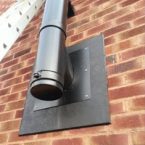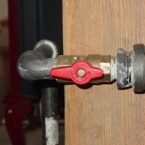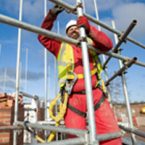London Chimney LinersFor all your chimney lining and repairs and much more!
Our Services
London Chimney Liners Ltd has been specializing in the supply and installation of chimney liners for both gas and solid fuel appliances for over a decade. We operate in both the private and commercial sectors and offer a complete “one stop shop”, including all related gas, electric and building work.

Chimney liners and terminals supplied and installed
When do chimneys/flues need to be lined?
1. Manufacturer’s recommendation – this includes all solid-fuel open fires and stoves, especially in older properties with masonry brick/render flues.
2. When 2 or more flues have been compromised – that is to say when 2 or more flues have been joined together, because the brickwork or mortar that separates the adjacent flues has fallen out. Every fireplace opening has its own independent flue, although they can share the same chimney breast or stack. If the flues become joined they no longer function correctly and can be dangerous. It is illegal to install either a gas or solid fuel appliance that is dependent on a compromised flue to evacuate the burned gas or smoke.
3. If the flue is greater than 12 metres in length – this is because at lengths greater than 12 metres there is a high probability of condensation, which in turn causes damp. Lining the chimney greatly reduces this problem.
4. In addition, lining a flue proves safer and more efficient.

Chimney liners and terminals removed
When do chimney/flue liners and cowls need to be removed?
1. When you have a gas liner and you want to convert to solid fuel. As solid fuel burns at a much higher temperature than gas does, solid fuel liners are much more robust than gas liners. Therefore, although burned gas can safely pass through a solid fuel liner, the reverse is not true, as solid fuel temperatures would soon burn a gas liner out.
2. When the diameter of a liner is not large enough to meet with current standards.
3. If the liner is damaged.
4. When the cowl doesn’t meet with current standards, eg. If a ventilation cowl is fitted above a working fireplace, thereby restricting the draw of the chimney and allowing carbon monoxide to enter the room.

Twin-wall insulated flues supplied and installed
Twin-wall insulated flue systems are required if there is no chimney in situ. They are for external use, either through an outside wall and up the side/back of the property, or up through the building and out the roof.

Chimneys repaired, rebuilt and repointed
So many of London’s chimneys are very old and in poor condition. We offer a complete chimney renovating service.

Chimney pots supplied and fitted
We replace chimney pots that are missing or damaged.

Spinning cowls and anti-downdraught cowls supplied and fitted
Ultimately, there are no guarantees how well a chimney will work – spinning cowls can help the draw. And if the top of your chimney pot is lower than some surrounding rooves or walls, downdraught becomes an almost certainty, wherby the wind rushes down the flue, instead of the other way. Special anti-downdraught cowls are available to rectify this.

Gas, solid fuel and electric fires and fireplaces installed
We have been specialising in the installation of gas, solid fuel and electric fires and fireplaces for well over a decade, as well as repairing and servicing gas fires. We operate in both the private and commercial sectors.

Gas and solid fuel stoves installed
Since the turn of the century, we have noticed the explosion in popularity of stoves, especially for solid fuel purposes. We believe the principal reason for this, is as an alternative heat source to gas and electric, whose costs are soaring and public confidence in the energy suppliers is at an all time low.
Stoves can be fitted in conjunction with a mantel or in a more minimalist style (see “Fireplace openings reinstated”)

Marble and cast iron fireplaces renovated
Broken, pieces missing or merely shabby – on site or at our workshop we restore marble mantelpieces, cast iron Georgian hob-grates and Victorian cast iron inserts and mantels.

Chimney breasts built and plastered
If the chimney breast has been removed in the living room or bedroom and a working fireplace is required, we can rebuild the breast and install an insulated twin-wall flue system either out through an external wall, or up through the building and exiting through the roof.

Constructional hearths reinstated
The constructional hearth is a slab of concrete or stone, approximately 6” thick, in every wooden floored house, in front of the chimney breasts, set level with the top of the floor. It is there to stop flames and heat reaching the joists and floor-boards and if removed, must be replaced, especially in the case of open fires.

Gas runs installed
No gas at the chimney breast? (Or anywhere else, for that matter!)
We can run a supply from either the gas meter or from a closer source, should a suitable one be available. This can be done under floorboards, surface run or channelled into concrete floors.
Gas runs also supplied vertically inside properties, surface run or channelled into plasterwork.

Wall and floor vents installed
Regulation regarding ventilation is generally as follows:
Gas – ventilation is obligatory at 7 kilowatts and above
Solid fuel – ventilation is obligatory above 5 kilowatts
And for any fires below the above specifications, should the chimney require help in drawing. Ventilation can be achieved in 2 ways:
Wall vents – A 4” diameter hole core-drilled through the wall and vent covers fitted either side
Floor vents (only possible with wooden floors) – A 100 cm2 hole cut in the floor and a metal vent cover fitted over the top.

Fireplace openings reinstated
You have a chimney breast, but the fireplace opening is blocked up and plastered – we can put the opening back, including beading to the top and side corners, plastering at the front and rendering inside for an all round clean, minimalist finish.

Fireplace openings rendered
Rendering is a sand/cement mix which gives a uniform, heat-proof finish to the inside of fireplace openings. This method is much longer lasting than plaster, which soon cracks. It can also be painted afterwards in water-based masonry primer and top coat.

Fireplace openings blocked and plastered
If you want your fireplace removed and the fireplace opening sealed up, we will take the fireplace out and brick up the opening for you. Then we can either plaster that area alone if the chimney breast is in reasonable condition, or replaster the whole breast.

Scaffolding
All our scaffolding requirements are met by our long-term working partners – SCAFFORCE

CCTV Chimney Surveys
If you need a good view to inspect possible internal damage to your chimney flue, we have the most up-to-date CCTV equipment to reveal all.






